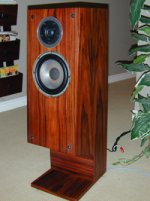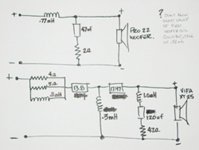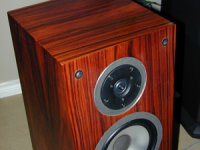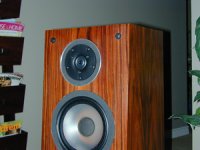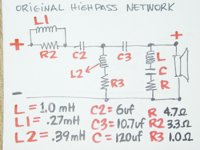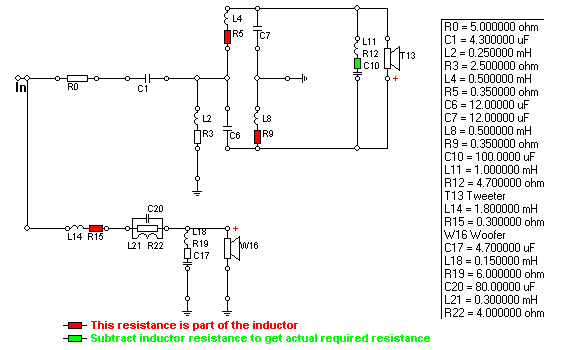Hey guys, here's the planned project for what will hopefully turn into an extremely high resolution speaker for me.
Advice and opinions are welcome as I want to go into this knowing pretty much what my outcome will be before I make the purchases. (The drivers in question are very expensive! as I'm sure the crossovers will be too) Hopefully, you guys who are very knowledgeable about crossover and driver technology can help me out here And yes, when I'm more confident about the driver choice after some discussion, I'm willing to pay someone to help me out with all the details too. Feel free to PM me and let me know how you can help me out and what your fees would be.
Cabinets - Energy 22 Reference Connoisseur in Rosewood
I believe the cabs are approx. 1.3 - 1.4 cubic inches for volume (my best guess) with a slot loaded port about 12" long, 9" wide and 1" high. This can't be changed other than maybe adding some more wood to take away volume if I need to do it.
A new 1.5" front baffle will be made and added to the front of the cabinet in exactly the same dimensions so it looks stock.
If you haven't seen these cabs before, they are extremely well built with a crap load of bracing and a sloped front baffle for added time alignment. Add this to the extra 1.5" front baffle and it will be extremely inert.
Driver Selection:
Woofer - Morel HU9.19 9" cast frame woofer from Parts Express
Sorry I don't know how to link the page to this post
But here are the parameters, VC dia: 3" Le: .87mH Impedance 8 ohms Re: 6.8 ohms Fs: 44 Hz SPL: 88db Vas: .69 Cu ft Qms 1.81 Qes: .40 Qts: .32 Xmax 4.25mm
Tweeter - MDT-33 Soft dome tweeter
Parameters, Impedance: 8 ohms Re: 5.2 ohms Fs: 700 Hz SPL 92.5 db
Crossover - Not sure here. I understand the drivers have very smooth rolloffs, so I'm guessing a lower order type of crossover, maybe something that will bode well for the sloped front baffle? Again here is where I'm hoping to get some help from some of the experts. I don't have the computer modeling programs and I really can't see myself starting to use them any time soon. But I do enjoy doing the speakers myself!
My goal here is to have a very high resolution speaker that will be accurate, detailed, yet very musical and non fatiguing.
I attached a picture of the cabinet that I want to use in this project. The reason I wanted to go this route is that I don't have the talent, time or patients to create the cabinets myself, so I was able to get these for a good price and hopefully I can come up with a winning design. On the back of the speaker, the base or stand is integrated into the rest of the speaker and it also houses the slot port.
If you think that my choice of drivers are wrong for my puproses of retrofitting these cabinets please feel free to suggest some alternatives. Remember that I will be adding another baffle to the front so the drivers don't have to match as far as size goes.
I simply wanted to look at Morel as I have heard some designs using them and they sounded great. Their reputation is top notch as well.
I was also thinking that some of the other drivers that I was considering usually want a larger cabinet so they may not work as well. For instance the Usher drivers and the Dayton Ref. drivers looked good but I think my cabinets are too small.
Also, if you need more info before making suggestions, ask away...
Thanks to all in advance for any advice or help that you can give me.
Advice and opinions are welcome as I want to go into this knowing pretty much what my outcome will be before I make the purchases. (The drivers in question are very expensive! as I'm sure the crossovers will be too) Hopefully, you guys who are very knowledgeable about crossover and driver technology can help me out here And yes, when I'm more confident about the driver choice after some discussion, I'm willing to pay someone to help me out with all the details too. Feel free to PM me and let me know how you can help me out and what your fees would be.
Cabinets - Energy 22 Reference Connoisseur in Rosewood
I believe the cabs are approx. 1.3 - 1.4 cubic inches for volume (my best guess) with a slot loaded port about 12" long, 9" wide and 1" high. This can't be changed other than maybe adding some more wood to take away volume if I need to do it.
A new 1.5" front baffle will be made and added to the front of the cabinet in exactly the same dimensions so it looks stock.
If you haven't seen these cabs before, they are extremely well built with a crap load of bracing and a sloped front baffle for added time alignment. Add this to the extra 1.5" front baffle and it will be extremely inert.
Driver Selection:
Woofer - Morel HU9.19 9" cast frame woofer from Parts Express
Sorry I don't know how to link the page to this post
But here are the parameters, VC dia: 3" Le: .87mH Impedance 8 ohms Re: 6.8 ohms Fs: 44 Hz SPL: 88db Vas: .69 Cu ft Qms 1.81 Qes: .40 Qts: .32 Xmax 4.25mm
Tweeter - MDT-33 Soft dome tweeter
Parameters, Impedance: 8 ohms Re: 5.2 ohms Fs: 700 Hz SPL 92.5 db
Crossover - Not sure here. I understand the drivers have very smooth rolloffs, so I'm guessing a lower order type of crossover, maybe something that will bode well for the sloped front baffle? Again here is where I'm hoping to get some help from some of the experts. I don't have the computer modeling programs and I really can't see myself starting to use them any time soon. But I do enjoy doing the speakers myself!
My goal here is to have a very high resolution speaker that will be accurate, detailed, yet very musical and non fatiguing.
I attached a picture of the cabinet that I want to use in this project. The reason I wanted to go this route is that I don't have the talent, time or patients to create the cabinets myself, so I was able to get these for a good price and hopefully I can come up with a winning design. On the back of the speaker, the base or stand is integrated into the rest of the speaker and it also houses the slot port.
If you think that my choice of drivers are wrong for my puproses of retrofitting these cabinets please feel free to suggest some alternatives. Remember that I will be adding another baffle to the front so the drivers don't have to match as far as size goes.
I simply wanted to look at Morel as I have heard some designs using them and they sounded great. Their reputation is top notch as well.
I was also thinking that some of the other drivers that I was considering usually want a larger cabinet so they may not work as well. For instance the Usher drivers and the Dayton Ref. drivers looked good but I think my cabinets are too small.
Also, if you need more info before making suggestions, ask away...
Thanks to all in advance for any advice or help that you can give me.
Attachments
Re: do you own the Connies?
Hey Nanook, yes I do own the Ref Conns. When I bought them the tweeters were no good. Although I've heard them before with good tweeters. I found the sound nice, but not exactly what I was looking for. Bass can be a little loose. That driver they use is not exactly what I would call a high resolution driver. Very simple steel stamped frame, small magnet and lots of xmax. It can definitely kick out some bass but just not the kind that I'm looking for. Which is my reason for doing a whole 'nother design.
I really want to be able to come up with something that sounds very real and very musical. I think some of the top drivers and even the mid line drivers can offer this if used appropriately.
I hope that I will be able to work something out .
Nanook said:if you do, what's wrong with them. Drivers may still be available from Energy.
These are very revealing, and with the right amplification cvan make absolutely beautiful music.
Hey Nanook, yes I do own the Ref Conns. When I bought them the tweeters were no good. Although I've heard them before with good tweeters. I found the sound nice, but not exactly what I was looking for. Bass can be a little loose. That driver they use is not exactly what I would call a high resolution driver. Very simple steel stamped frame, small magnet and lots of xmax. It can definitely kick out some bass but just not the kind that I'm looking for. Which is my reason for doing a whole 'nother design.
I really want to be able to come up with something that sounds very real and very musical. I think some of the top drivers and even the mid line drivers can offer this if used appropriately.
I hope that I will be able to work something out .
fazman,
If you've got Energy 22 Reference Connoisseurs, and not a lesser version of the 22's, then you have a speaker that probably can't be bettered for a few $K. The speakers that you may have heard (as Ref Con 22's) may not have been the model that you now have. Remember that these were chosen by both CBS and NBC as their studio monitor speakers. Thay might not have the bass extention you require, but they'll be pretty good other than that. you will need some amplification to drive them however.
Try here on audioasylum for a few comments.
Consider that, by doing the mods that you are planning, you will trash a really good speaker. Simply grabbing a pair of the replacement tweeters would give you a $1000 (at least) headstart on a real project budget using the drivers you are planning to use.
Please don't trash some audio classics because you are too lazy to do some simple cutting and gluing. Please?
If you've got Energy 22 Reference Connoisseurs, and not a lesser version of the 22's, then you have a speaker that probably can't be bettered for a few $K. The speakers that you may have heard (as Ref Con 22's) may not have been the model that you now have. Remember that these were chosen by both CBS and NBC as their studio monitor speakers. Thay might not have the bass extention you require, but they'll be pretty good other than that. you will need some amplification to drive them however.
Try here on audioasylum for a few comments.
Consider that, by doing the mods that you are planning, you will trash a really good speaker. Simply grabbing a pair of the replacement tweeters would give you a $1000 (at least) headstart on a real project budget using the drivers you are planning to use.
Please don't trash some audio classics because you are too lazy to do some simple cutting and gluing. Please?
I hate to sound like a party pooper but here goes:
You need to know as much information about the drivers and crossovers in those speakers as possible, otherwise you won't be successful. You need to find a woofer that is a close match for the cabinet design, otherwise who knows what it will sound like. You will need to build a new crossover to match the woofer and tweeter. And even if you are successful, you have just spent hundreds of dollars on new drivers and crossovers that you are going to put in a particle-board box designed in 1982?
Sorry if I sound a little harsh, but if you want great sound why not start from scratch with a proven design that is known to sound good and has all the bugs worked out for you.
Jeff
You need to know as much information about the drivers and crossovers in those speakers as possible, otherwise you won't be successful. You need to find a woofer that is a close match for the cabinet design, otherwise who knows what it will sound like. You will need to build a new crossover to match the woofer and tweeter. And even if you are successful, you have just spent hundreds of dollars on new drivers and crossovers that you are going to put in a particle-board box designed in 1982?
Sorry if I sound a little harsh, but if you want great sound why not start from scratch with a proven design that is known to sound good and has all the bugs worked out for you.
Jeff
vinylkid58 said:Sorry if I sound a little harsh, but if you want great sound why not start from scratch with a proven design that is known to sound good and has all the bugs worked out for you.
Jeff,
It looks like we're giving similar advice from the opposite viewpoint. The cabinet that he's planning is really solid, very well designed. I think they used to go for around $5000 over here in the early '90's - so they weren't cheap.
Personally, I think fazman would find buying replacement tweeters, and then building something to fortify the bass, would give him an excellent system.
"Diff'rent strokes" and all that...
Edit:
fazman, check out this thread on restoring these speakers. Maybe it will change your mind...
Cloth Ears said:
Personally, I think fazman would find buying replacement tweeters, and then building something to fortify the bass, would give him an excellent system.
I just found an ebay listing here in Canada for a guy who will repair the tweeters to their former glory for $160 USD EACH! So that's $320 US just to fix the tweeters, and you still have the stock crossover to deal with.
Jeff
Ref Connies are yours?
fazman,
well if the tweeters are shot, a rebuild could be in order or a replacement from Vifa/Morel, etc could be had...remeber the NRC and API spent something in the neighbourhood of $1M to develop..it would be worth getting them fixed. As far as cleaning up the bass have a read through the thread that Cloth Ears provided. replace the caps with good ones, tight tolerences, and air core inductors instead of iron core.
The Reference Connies were/are still a great speaker, and with a little bit of work can still see off a good many speakers (and certainly any in the $500=1000 range which is what you may end uip having into them depending on your buy in).
fazman,
well if the tweeters are shot, a rebuild could be in order or a replacement from Vifa/Morel, etc could be had...remeber the NRC and API spent something in the neighbourhood of $1M to develop..it would be worth getting them fixed. As far as cleaning up the bass have a read through the thread that Cloth Ears provided. replace the caps with good ones, tight tolerences, and air core inductors instead of iron core.
The Reference Connies were/are still a great speaker, and with a little bit of work can still see off a good many speakers (and certainly any in the $500=1000 range which is what you may end uip having into them depending on your buy in).
Hi,
FWIW the bass drivers could be modded with some damping on the
frame and possibly P10's duct seal modification (photos in the other
thread are not good enough to tell.) The tweeter could be replaced
by a Seas or the new Peerless with will handle 18dB/oct @ 1.5kHz.
Zaph is no fan of Morel drivers see tests at : http://www.zaphaudio.com/
The bass drivers are probably worth quite a bit as replacements,
so if you really want to change them out probably a valid option.
What is not so valid is finding another 8" that suits ~ 35L vented ....
 /sreten.
/sreten.
FWIW the bass drivers could be modded with some damping on the
frame and possibly P10's duct seal modification (photos in the other
thread are not good enough to tell.) The tweeter could be replaced
by a Seas or the new Peerless with will handle 18dB/oct @ 1.5kHz.
Zaph is no fan of Morel drivers see tests at : http://www.zaphaudio.com/
The bass drivers are probably worth quite a bit as replacements,
so if you really want to change them out probably a valid option.
What is not so valid is finding another 8" that suits ~ 35L vented ....
Cloth Ears said:fazman,
Please don't trash some audio classics because you are too lazy to do some simple cutting and gluing. Please?
Hey Cloth Ears, beleive me I am not lazy... My wife thinks I am though. I don't think that this undertaking is an option for a lazy person
In fact if I were to restore instead of replace.... Then the cutting and gluing would not be necessary.
I happen to think that no matter what Energy's design philosophy happened to be at the time, advancements in todays driver technology is superior and therefore will allow you to make a higher resolution speaker. Cost was certainly on the minds of the people at Energy when they built this speaker I'm sure. Even though they used quality parts and the cabs are very well built there would have had to have been a financial cutoff somewhere...?
Having said all that, I'm not completely opposed to restoring if in fact I would be able to acheive my objectives.
The hyperdome tweeter did sound good when I listened to it on its own, but compared to the Vifa XT-25 I own, I thought the Vifa sounded much better and more robust especially near the lower octaves.
Now here's another option I guess I could look at.... If I were to leave the woofer, use the same lowpass but use my Vifa and adjust the highpass to compensate... would this be an option?
As I understand it, this speaker crossed over at 1500 hz correct?
I'm wondering if the Vifa is comfortable that low...
fazman said:
The hyperdome tweeter did sound good when I listened to it on its own, but compared to the Vifa XT-25 I own, I thought the Vifa sounded much better and more robust especially near the lower octaves.
Now here's another option I guess I could look at.... If I were to leave the woofer, use the same lowpass but use my Vifa and adjust the highpass to compensate... would this be an option?
As I understand it, this speaker crossed over at 1500 hz correct?
I'm wondering if the Vifa is comfortable that low...
Hi,
The c/o point is described as 1.5Khz 18/dB octave electrical.
According to Zaph :
The XT25 is a tweeter without ferrofluid and it has a huge, sharp impedance peak. The conjugate notch is required. Without it, the tweeter will ring at the Fs, causing audible distortion. It's a little more obvious with an LR2 system. The XT25 is one of the most misused tweeters around because many choose to use it without a notch, and the shunt resistor in an L-pad often isn't enough to damp the peak.
Vifa XT25 ($54) - Smoothest and most extended response curve in the group, and resulting CSD is excellent. Good tall order HD above 2kHx, but average 2nd order HD. Poor HD levels of all types below 2kHz, even considering the extended low end. It may have a 500 Hz Fs, but don't think about crossing it below 2kHz LR4 or 2.5kHz LR2.
http://www.zaphaudio.com/tweetermishmash/
So not the most ideal tweeter to try as a replacement, unless you
add a 4.7R, 1.0mH, 100uf compensation circuit. note the LR4/LR2
above are acoustic slopes so 18dB electrical might be OK.
Peerless 810921 or Seas 27TDFC are better bets / more straightforward.
Because the c/o has no tweeter impedance compensation, and they do not need it.
sreten said:
Hi,
The c/o point is described as 1.5Khz 18/dB octave electrical.
According to Zaph :
http://www.zaphaudio.com/tweetermishmash/
So not the most ideal tweeter to try as a replacement, unless you
add a 4.7R, 1.0mH, 100uf compensation circuit. note the LR4/LR2
above are acoustic slopes so 18dB electrical might be OK.
Peerless 810921 or Seas 27TDFC are better bets / more straightforward.

Because the c/o has no tweeter impedance compensation, and they do not need it.
/sreten.
Sreten, would I be looking at typical textbook values at 1500 hz on a third order with the LCR trap for the XT or is there a better method of trying to come up with the high pass to match what I have?
Sorry I admit my ignorance regarding crossover values... I do have lots of caps coils and resistors to experiment with though
fazman said:Hey Cloth Ears, beleive me I am not lazy... My wife thinks I am though. I don't think that this undertaking is an option for a lazy person
Sorry fazman, I wasn't really trying to intimate that you were lazy, I was just using a bit of hyperbole to possibly get you to reconsider changing the speakers rather than restoring them. As I have seen - from prices of Tannoy drivers on eBay (amongst others) - not all driver technology from last century is considered "old".
I see you are an AK member, so you may have seen the thread regarding an infamous article in the Boston Globe (here). If you read this article then you can see my reason for kicking up a fuss.
There are a couple of other articles on rebuilding these speakers (with different tweeters, etc) also on the AK site. And, I believe Energy will rebuild the tweeters for $110 each (not sure if that's $Can or $US, though).
But, they are lovely cabinets, and I applaud any efforts to keep them in circulation.
Incidentally, you can 'measure' the volume (it's a bit rough) by filling the enclosure with thos polystyrene balls (from bean chairs) and then pouring them out again into a container. Not as accurate as water, but much better for the cabinets.
And, as this letter from the Parts Manager of Energy (2006) indicates, the Energy 22's are still considered worth repairing:
Dear sir:
There is no design flaw with the Energy 22. The way most tweeters are constructed is that the voice coil of the tweeter sits in a gap in the magnet structure. In the gap, "Ferro fluid" is added as a coolant. Through normal use, the tweeter voice coil heats up and cools down but after many years, (10 -12), the Ferro fluid dries out and the tweeter is no longer being cooled as originally designed. The tweeter will then run hotter and the constant heating and cooling causes metal fatigue in the voice coil wire and it eventually will break. This is a normal aging process of the tweeter and we do rebuild the tweeters by replacing the dome, voice coil and Ferro fluid. The average life on the Energy 22 tweeters is approximately 12 years. Considering these speakers are in excess of 20 years old, we do see a lot of tweeter rebuilding.
The other problems we see is burning of the voice coil which is due to too much current. The high current can be attributed to 3 different scenarios.
1. Too much power. In excess of 100watts.
2. Too little power - distortion. Speaker operate on AC current which allows the cone/dome to move in and out creating sound. When too small an amplifier is used, there is a tendency to turn the volume up to the maximum. Depending on the quality of the amplifier, when the volume exceeds 3/4 of the potential, the distortion increase exponentially. Distortion causes the signal to become square wave or pulsating DC current. This causes the cone/dome to stall slightly as it moves in and out, which in turn causes a heat build up and burns the coil. (Also accelerating the evaporation of the Ferro fluid - coolant).
3. Shorted Amplifier outputs. - Normally when the output transistor go, they open and just shut off output from the amp. In about 10% of the cases the outputs short closed and put DC current into the drivers. This causes the voice coils to move in one direction and stay there. The coil then heats up until burning out and breaking the circuit. This can happen so quickly that the voice coil can burn out before a fuse would have time to react, especially a slo blow fuse.
I hope this answers your concerns and adding a fuse will not hurt the tweeter but I am not sure if it will help in most cases. Years ago, resetable circuit breakers were used in speakers, however as the speaker's aged the circuit breakers were kicking off to early causing a false shutdown. That is why they were discontinued. A properly matched amplifier kept below 3/4 volume will have the most effect on tweeter life.
Regards
Steve Hipgrave
Parts and Service Manager
Edit: If you're considering the XT25, I wouldn't try using the original xover point (1.5kHz), as (Zaph) points out "don't think about crossing it below 2kHz LR4 or 2.5kHz LR2". Looking at the manual, I like the way that the Connoisseur's were solds as pairs match to one-eighth dB - wow!
Hi,
The XT25 might work OK with an added LCR circuit.
Still my recommendation would be the Seas 27TDFC.
The c/o values in the current crossover should be fine,
better than using any text book values.
If tweeter level needs adjusting use an L-pad on the tweeter.
Ideally you would measure, but if you assume the old tweeters
have no nasties, then the 27TDFC is the best replacement.
(The Peerless is better, but needs crossover adjustments.)
 /sreten.
/sreten.
The XT25 might work OK with an added LCR circuit.
Still my recommendation would be the Seas 27TDFC.
The c/o values in the current crossover should be fine,
better than using any text book values.
If tweeter level needs adjusting use an L-pad on the tweeter.
Ideally you would measure, but if you assume the old tweeters
have no nasties, then the 27TDFC is the best replacement.
(The Peerless is better, but needs crossover adjustments.)
sreten said:Hi,
The XT25 might work OK with an added LCR circuit.
Still my recommendation would be the Seas 27TDFC.
The c/o values in the current crossover should be fine,
better than using any text book values.
If tweeter level needs adjusting use an L-pad on the tweeter.
Ideally you would measure, but if you assume the old tweeters
have no nasties, then the 27TDFC is the best replacement.
(The Peerless is better, but needs crossover adjustments.)
/sreten.
Thanks, I went ahead and put something together based on some help and I incorporated the LCR you suggested... And it sounds really good. I took some crude measurements with my Rat Shack meter and it was surprisingly smooth at the crossover frequency, no dips or peaks that I could detect. Now unless there is something dreadfully wrong with what I did, I would like to know about it.
I attached a pic of the layout of the crossover
Lowpass values are original... .77mh, 47uf, and 2ohms
Highpass... 2.2ohms in line with a .11mH coil for a bit of response flattening
13.8uf cap, then a .3mH coil, then a 17.47uf cap , then the LCR network of 1.0mH, 120uf ,and 4.7ohms
Am I off with these values, cause it certainly doesn't sound like I am...
Attachments
sreten said:Hi, why 120uF instead of 100uF for LCR circuit ? ,/sreten.
Hi Sreten, I remember reading much about the LCR network for the Vifa XT and I seem to remember that 120 was the cap value used. I also had another speaker brand that used the XT and they used a 150uf cap as part of the LCR network.
I will take your word for the fact that is a 100uf cap though
Kind of an update here... I took your advice you gave previously and used the original high pass network that was in the speaker to begin with and the results are much better now. In fact the amount of attenuation was just about right as well. But it does need the LCR network. You can hear it struggling in the lower end of its response.
I'm surprised by this as I always thought that the original hyperdome tweeter was an 8 ohm driver...
I was told that the effective crossover using the original high pass unit and using the XT Vifa is 2khz.
I don't know but some of my crude measurements that I took with a Rat Shack meter show that it is very smooth in the crossover region with no major dips or bumps. I like it. Whether or not is is completely technically accurate or not, the sound is nice compared to some other speakers I have lying around.
I attached the original high pass crossover network being used with a few additions.
Attachments
- Status
- This old topic is closed. If you want to reopen this topic, contact a moderator using the "Report Post" button.
- Home
- Loudspeakers
- Multi-Way
- Long post! Speaker retrofit project... Advice, help, suggestions welcome
